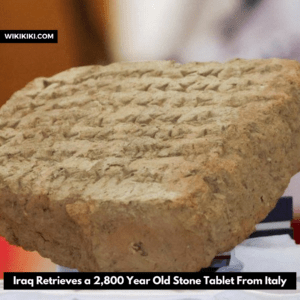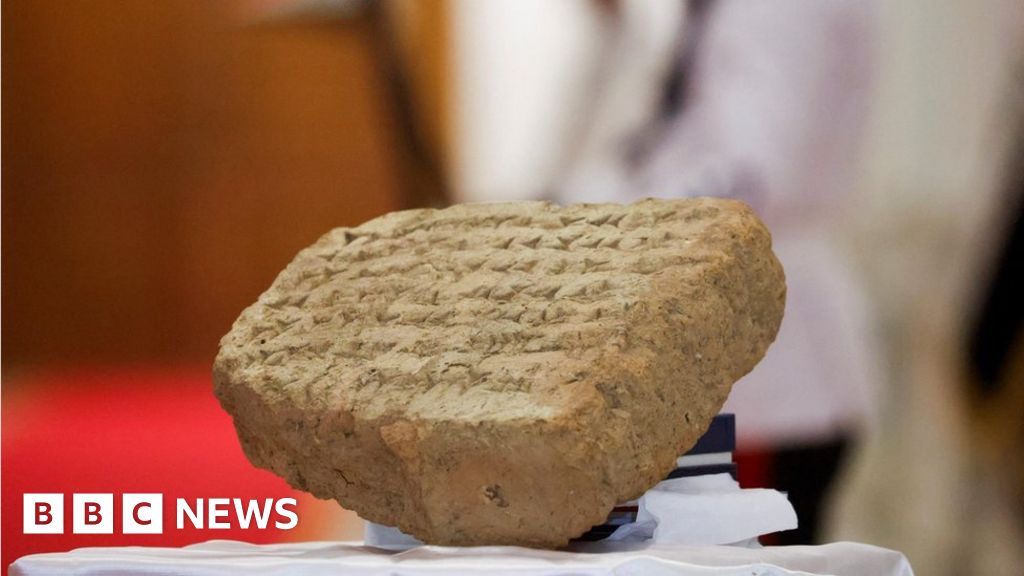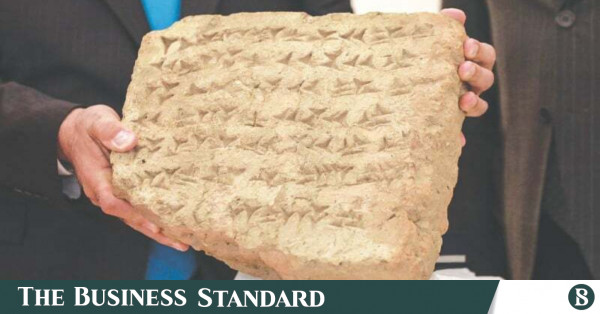A 2,800-year-old stone tablet has been returned to Iraq by Italy and set on exposition in the country after closely four decades. The Stone tablet is inscribed with comprehensive cuneiform textbook, which is a system of authoring exercised in ancient Babylon.
The Stone Tablet is larger than numerous other clay tablets set up in Iraq and bears the insignia of Shalmaneser III, an Assyrian king who controlled the Nimrod region in present-day- day northern Iraq from 858 to 823 BC. The Stone tablet’s exact origin and how it rounded up in Italy, where it was seized by the authorities in the 1980s, remain unclear.
Iraqi Culture Minister Ahmed Badrani indicated that it might have been set up during archaeological excavations of the Mosul dam, which was built around the same time. Iraq has been working out to recover looted and stolen artifacts, especially since the boost in looting following the US- led invasion in 2003. The country’s president expressed gratefulness for Italy’s cooperation and committed to remain efforts to recover further archaeological pieces of Iraqi history from everywhere.
This antique, adorned with comprehensive cuneiform text in the ancient Babylonian alphabet, holds invaluable insights into the ancient societies that prospered in what’s now ultramodern- day Iraq. The Stone tablet bears the insignia of Shalmaneser III, an Assyrian king who ruled the Nimrod region from 858 to 823 BC. Its extradition marks a significant milestone in Iraq’s ongoing efforts to recover its looted and stolen antiquities.
Iraq, frequently referred to as the” cradle of civilization,” is famed for its rich historical and artistic heritage. It’s home to ancient societies similar as the Sumerians, Akkadians, Babylonians, and Assyrians, which contributed significantly to the evolution of writing systems, the establishment of the first metropolises, and the enhancement of colorful fields of knowledge.
The 2,800- time- old stone tablet embodies this heritage and offers a glimpse into the history. Its cuneiform textbook provides precious insights into the language, governance, and customs of the time, shedding light on the political and social dynamics of ancient Iraq.
2,800 Year old Stone Tablet
After nearly four decades, Italy handed over over the expensive antique to Iraq’s President Abdul Latif Rashid during his visit to Bologna. This symbolic act of returning the tablet signifies the growing international cooperation in combating the illicit trade of artistic heritage and acknowledges the significance of conserving Iraq’s historical heritage.
Also Read: 15th Century Heege Manuscript Reveals Medieval Stand Up Comedy
The stone tablet’s comprehensive cuneiform textbook is a testament to the complication and intellectual prowess of ancient Mesopotamian societies. Cuneiform, derived from the Latin term” cuneus” meaning” wedge,” was a writing system that utilized wedge- shaped marks on clay tablets. It was first developed by the Sumerians around 3500 BCE and later adopted by other societies, involving the Babylonians and Assyrians.
This form of writing allowed for the documentation of various aspects of society, involving legal codes, religious textbooks, literature, and administrative records. The Stone tablet’s inscription offers precious insights into the daily lives, beliefs, and cultural practices of the people who inhabited the region thousands of times ago.
Iraq’s historical and cultural significance can not be exaggerated. Often referred to as the” birthplace of society,” the region known as Mesopotamia was home to some of the world’s foremost societies, involving the Sumerians, Akkadians, Babylonians, and Assyrians.
These ancient cultures laid the foundations for numerous aspects of human society, involving writing, the evolution of cities, legal systems, and complex social structures. The House of Wisdom, located in Baghdad during the Islamic Golden Age, was a famed center of learning and housed one of the largest libraries in the ancient world, containing invaluable textbooks on various fields of knowledge.
Also Read: The Codex Sassoon: 1,100-Year-Old Hebrew Bible Sells for $38 Million
The invasion of Iraq in 2003 resulted in a surge of looting and the unlawful trade of antiquities. The preceding chaos and lack of security provided fertile ground for looters to exploit archaeological sites and steal invaluable artifacts. During the 1990s, Iraq faced extreme poverty due to international sanctions, leading to a crime wave that extended to the smuggling of heritage.
The plundering of Iraq’s antiquities not only deprived the country of its cultural treasures but also fueled the illicit market for stolen artifacts worldwide. Efforts to combat this issue have been ongoing, with increased cooperation between Iraq and international mates to recover and repatriate looted artifacts.
Video: Iraq: displays 2800-year-old stone tablet returned by Italy
Also Read: Saqqara Necropolis: Egypt Unveils Ancient Workshops and Tombs






:quality(70)/cloudfront-eu-central-1.images.arcpublishing.com/thenational/VWTRTNOZ3L2MULMXCBMZDDZ3LM.jpg)



















+ There are no comments
Add yours